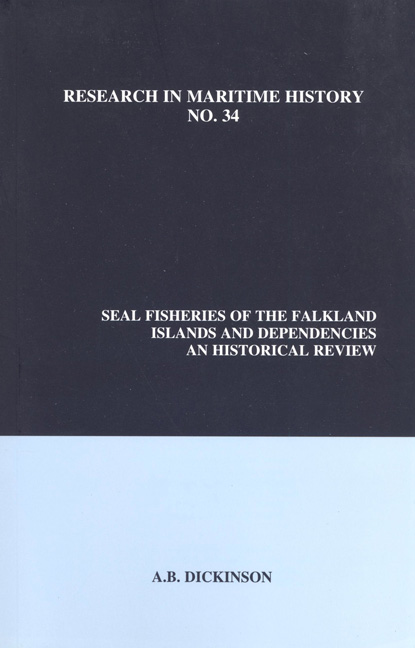Book contents
- Frontmatter
- map
- Contents
- List of Tables in the Text
- List of Illustrations
- About the Author
- Chapter 1 Introduction
- Chapter 2 Unregulated Sealing in the Falkland Islands
- Chapter 3 The Development of a Regulated Industry
- Chapter 4 Unregulated Sealing in the Dependencies
- Chapter 5 Regulated Sealing in the Falkland Islands, 1881-1914
- Chapter 6 Pelagic Sealing
- Chapter 7 Twentieth-Century Sealing on the Falkland Islands
- Chapter 8 Controlled Sealing at South Georgia
- Chapter 9 Aftermath
- Appendices 1-8
Chapter 4 - Unregulated Sealing in the Dependencies
- Frontmatter
- map
- Contents
- List of Tables in the Text
- List of Illustrations
- About the Author
- Chapter 1 Introduction
- Chapter 2 Unregulated Sealing in the Falkland Islands
- Chapter 3 The Development of a Regulated Industry
- Chapter 4 Unregulated Sealing in the Dependencies
- Chapter 5 Regulated Sealing in the Falkland Islands, 1881-1914
- Chapter 6 Pelagic Sealing
- Chapter 7 Twentieth-Century Sealing on the Falkland Islands
- Chapter 8 Controlled Sealing at South Georgia
- Chapter 9 Aftermath
- Appendices 1-8
Summary
Sealing in the Dependencies began on South Georgia (see figure 4.1). The discovery of the island is usually attributed to the British merchant Antonio de la Roche who in 1675 sighted what are now known as the Clerke Rocks off the northwest tip of the island. The first to land was Capt. James Cook, who went ashore from Resolution in what is now Possession Bay on 17 January 1755 to claim the island for King George III. Unfortunately, his visit brought about one of the largest slaughters of marine mammals ever. In the published account of his travels (see figure 4.2), Cook recorded that “perhaps the most abundant we saw were females, for the shores swarmed with young ones.” Although Cook's fellow voyager, Johann Forster, thought they would not be hunted since they were easier to get at the Falklands and in South America, news of the discovery prompted London merchants to despatch sealing crews after the War of Independence. The first to arrive may have been Lord Hawkesbury (Capt. Thomas Delano, Jr.), owned by Champion Bros., and Lucas (Capt. Thomas Smith), owned by Lucas and Spencer, which left England in 1786. The departure of Francis Rotch's vessel, Ann (Capt. Pitman), from London in June 1792 marked the beginning of annual voyages to the island from England for the next decade. Its crew obtained fifty tons of elephant seal oil and 50,000 skins. Pitman described sealing in a letter to Francis Rotch:
the small skins are of little value. They are chiefly used here [London] among the Tanners and recorded excellent for shoes, and the larger are the best. A vessel…capable of bringing near 100 tons of oil may bring upwards of 30,000 good sizeable skins…the skins packed in bulk have come out in much better order than those packed in Casks because they have an opportunity of examining them and salting them even if necessary. Other ships continued until the month of May and came away quite full.
During his visit to the Falkland Islands in Rattler in 1793, Capt. Colnett learned from sealers that many profitable voyages had already been made. Some twenty-five years later, Capt. James Weddell reported, however, that the sealers were now primarily searching for elephant seal oil.
- Type
- Chapter
- Information
- Seal Fisheries of the Falkland Islands and DependenciesAn Historical Review, pp. 61 - 78Publisher: Liverpool University PressPrint publication year: 2007

